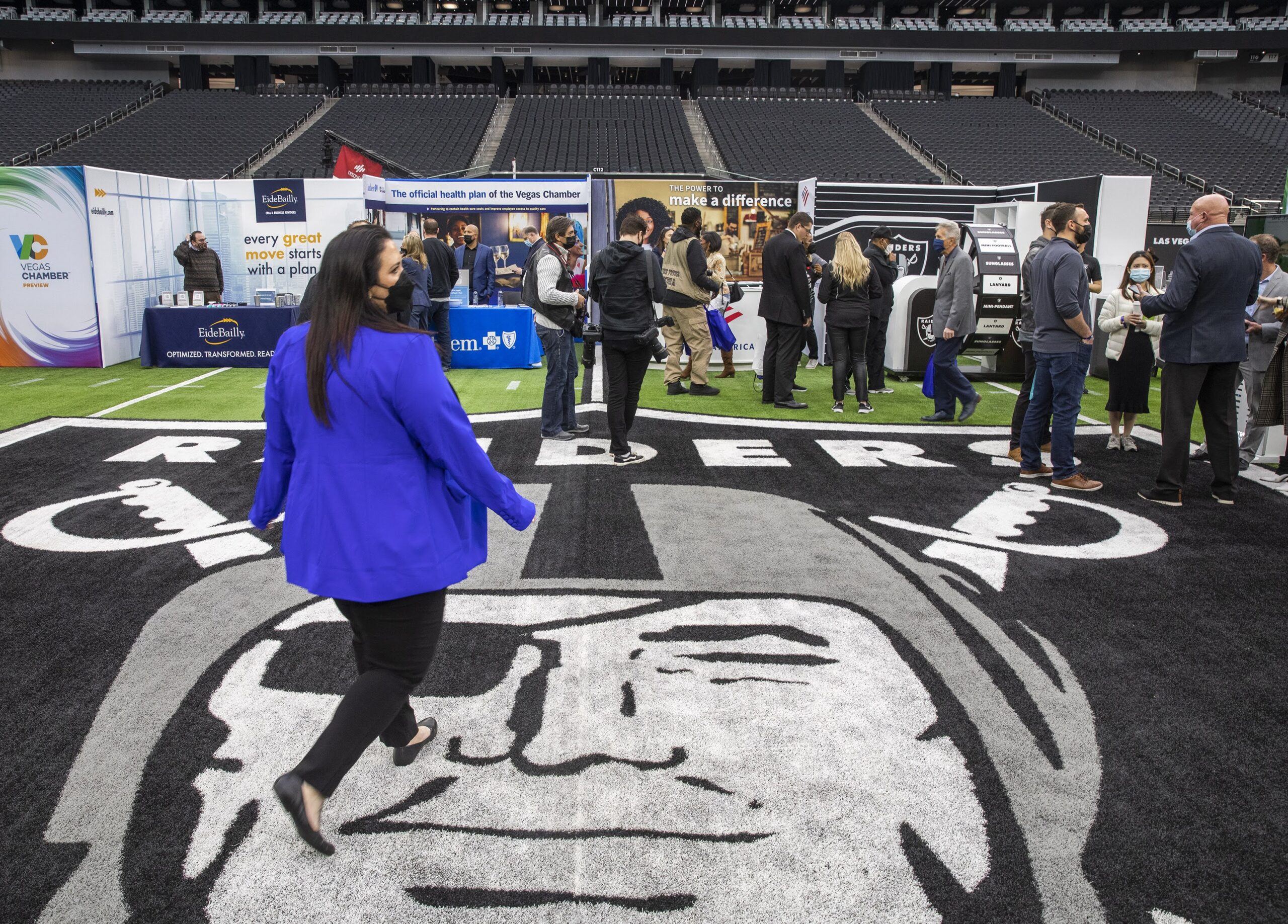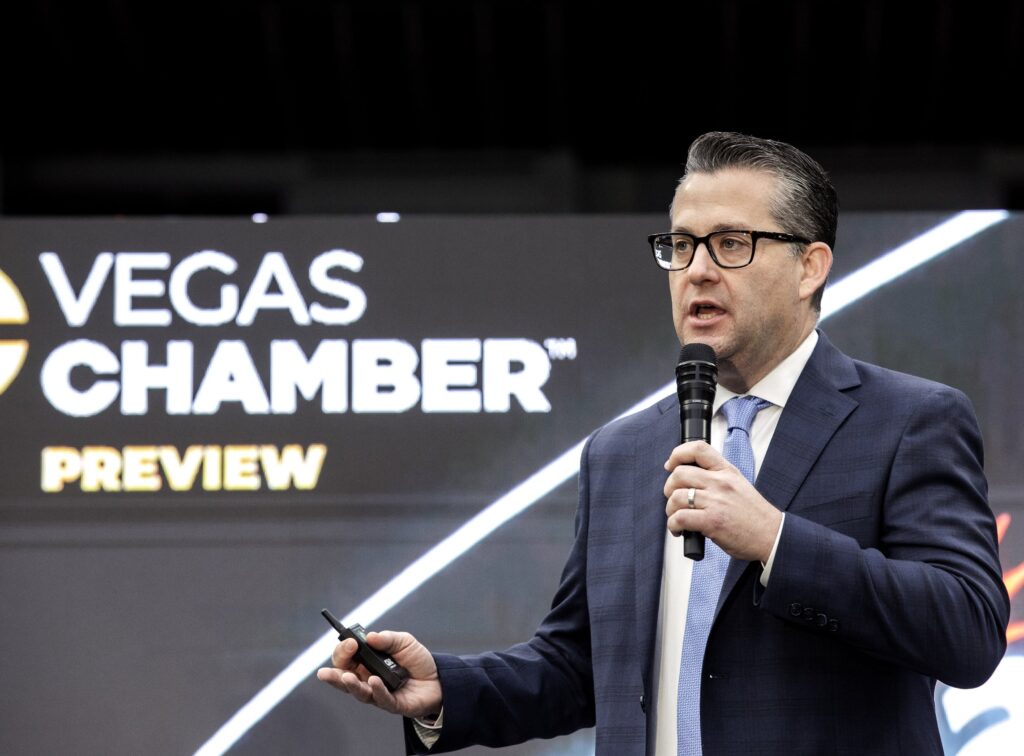Road to Recovery: Asymmetrical recovery tempers rosy Vegas economic outlook

Welcome to the sixth installment of “Road to Recovery,” a recurring feature that provides semi-regular updates on Nevada economic news and data.
The state’s economy has been hit hard by the COVID-19 pandemic, and many parts of the economy have yet to return to their pre-pandemic state. As Nevada’s recovery continues, this series will take a closer look at the most important economic indicators across the state.
You can find the latest data on our “Nevada Recovery Dashboard” data page and on Twitter. (Follow Tabitha Mueller for updates on housing data and Howard Stutz for updates on gaming and tourism numbers). Also, feel free to reach out to [email protected] with any questions.
Below, we explore predictions for the future of the Southern Nevada economy shared last week at Preview Las Vegas, an annual networking and forecasting event hosted by the Vegas Chamber.
The event, which took place on the Raiders’ home turf at Allegiant Stadium, saw scores of business representatives come together for discussions about the city’s economy and featured more than 70 exhibits representing a range of national and local businesses from Bank of America to Las Vegas retailer Old School Tees.
The primary message was positivity, as several speakers, including Gov. Steve Sisolak, sought to highlight the bright future of the region’s economy. But other experts, including Applied Analysis Principal Brian Gordon, tempered the optimism by noting the outstanding challenges Nevada faces, including supply chain issues and unsustainable gains in housing prices.
The asymmetrical recovery
Gordon kicked off his presentation to the Preview’s 1,100 attendees with a look back at the early days of the pandemic, when toilet paper was flying off store shelves and one of the world’s largest container ships became lodged in the Suez Canal, causing widespread disruptions to global trade. Nearly two years later, the U.S. continues to deal with a supply chain crisis, and Gordon pointed to ongoing issues at the country’s top container port in Los Angeles.
“We're talking about $32 billion worth of goods that are parked outside of the Los Angeles shores,” he said.
As consumer spending increased last year, the heightened demand and limited supply — caused in part by shipping challenges — led to an increase in the prices of goods. Gordon likened the situation to 1982, the last time the country’s year-over-year inflation rate was as high as it was in December 2021, and noted that higher prices are present across the market.
“We have single-family homes going up 23 percent year on year,” he said. “I'm going to tell you right now these levels of gains are clearly unsustainable.”
Gordon’s message stood in contrast to Sisolak’s primarily positive outlook. The Democratic governor is in the midst of a re-election campaign this year and is fending off economy-focused attacks by Republicans.
“I'm here to tell you that the future of Nevada and the future of Las Vegas is as bright as it has ever been,” Sisolak said. “Here we are leading the nation in economic growth … Here we are just down the street from the fabulous Las Vegas Strip, filled with visitors in hotels and casinos that were closed just 19 months ago.”
Differing messages about the economic recovery’s trajectory help illustrate just how uneven the progress has been.
“The recovery has been asymmetrical,” Gordon told The Nevada Independent after his speech. “We have not seen all of the visitors come back. We have not seen all of the jobs come back in the leisure and hospitality industry. At the same time, we see big job gains in things like trade, transportation and utilities.”
The effects of that asymmetrical recovery can be seen across the state.
Gaming revenue has soared and recorded all-time highs, while visitor volume remains below 2019 levels amid a sluggish return of international and convention travelers.
The unemployment rate throughout Nevada’s northern and rural counties has rebounded to pre-pandemic levels, while the Las Vegas metropolitan area continues to see one of the nation’s highest unemployment rates.
Rising home prices — alongside higher incomes and stock prices — led to an increase in household wealth last year, Gordon said, as homeowners saw the value of their assets rise. But homebuyers are facing greater prices and limited inventory, as construction costs rise amid labor and supply shortages.
“If you're a home seller, congratulations, you already sold your home,” Gordon said. “If you're a home buyer, I'm sorry, keep looking because it isn't going to happen too quickly.”
Gordon also noted that even as jobs have been filled across the Las Vegas Valley, many people have left the workforce entirely.
“Where did the workers go?” he asked. “They're out golfing, they're traveling, they're sitting on the couch watching Jeopardy. I don't know, but they have not come back to work.”
Nevada’s labor force participation rate — which represents the percentage of the civilian noninstitutional population aged 16 and older that is actively working or looking for work — remains about 4 percentage points lower than it was prior to the pandemic, a change driven in part by retirees. Gordon said that compared with past years, a much higher portion of people leaving the workforce are doing so to retire.
Despite the tightening labor market, Gordon said the ongoing labor changes are paving the way for economic diversification and less dependence on the volatile tourism industry, a dynamic that other Nevada economists have also highlighted.
“We've seen people transition into other industries because we're seeing gains elsewhere,” Gordon said. “And I think if we can continue to see some of that momentum, I think it just provides stability on a go-forward basis.”

Sports tourism a bright spot
Despite other obstacles facing Southern Nevada’s economy, Las Vegas’s burgeoning sports tourism market and major projects in development are reasons to be hopeful about the future, experts said.
Gordon pointed to nearly $22 billion in local construction projects underway, including the Fontainebleau resort, the MSG Sphere and Henderson’s Dollar Loan Center, which will contribute to the “full recovery of the tourism industry.”
One project completed less than two years ago, the nearly $2 billion Allegiant Stadium — funded in part by $750 million of hotel tax dollars — hosted more than 400,000 attendees in the second half of 2021, nearly 80 percent above projections made before the stadium’s construction.
Marketing guru Billy Vassiliadis said the stadium has helped attract a variety of new events to the city that otherwise never would have happened, including major concerts, soccer games and a Super Bowl, which Las Vegas will host in 2024.
“This stadium has expanded the opportunities for Las Vegas, not just for tourism, but to the benefit of the entire business community,” he said.
Recent additions of professional hockey and football teams have spurred the growth of sports tourism in Las Vegas, which Vassiliadis compared to the 1990s reinvention of the city when new resorts, including the Bellagio and Mandalay Bay, sprouted up at a rapid pace.
Moving forward, Las Vegas Convention and Visitors Authority CEO Steve Hill hopes to continue the expansion of sports in Southern Nevada.
“We've talked a lot about football, but it's so much more than that… It's what made Vegas what it is over the years,” Hill said. “I mean, it's boxing, it's NASCAR, it's the Shriners Open, it's virtually every sport out there. But there's more coming, and it is making a huge difference in Las Vegas.”
